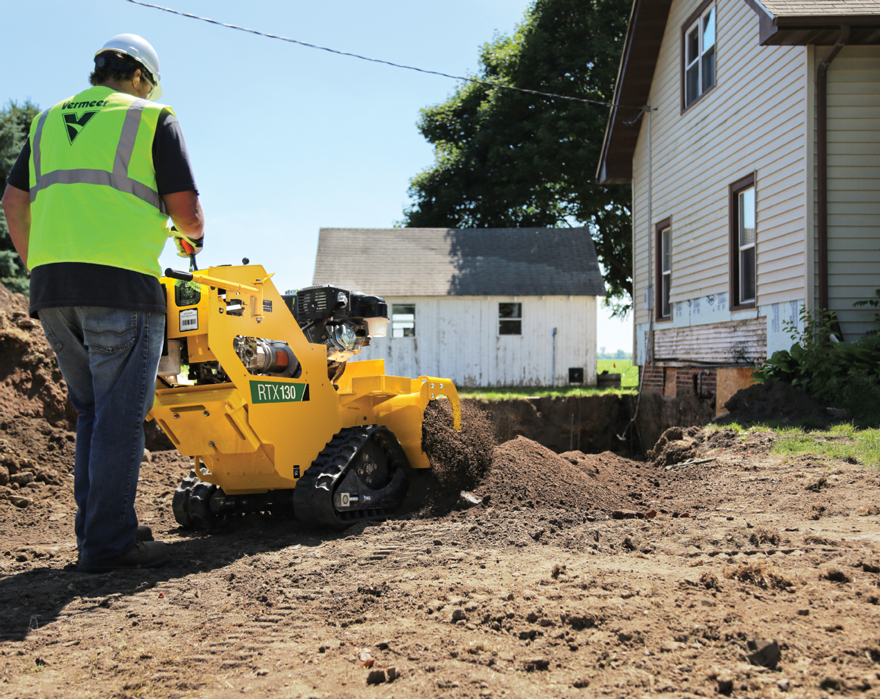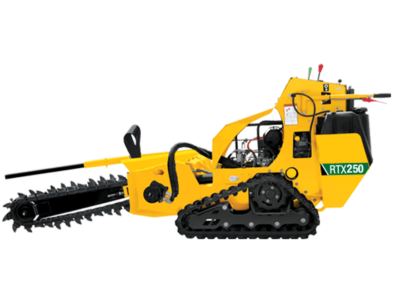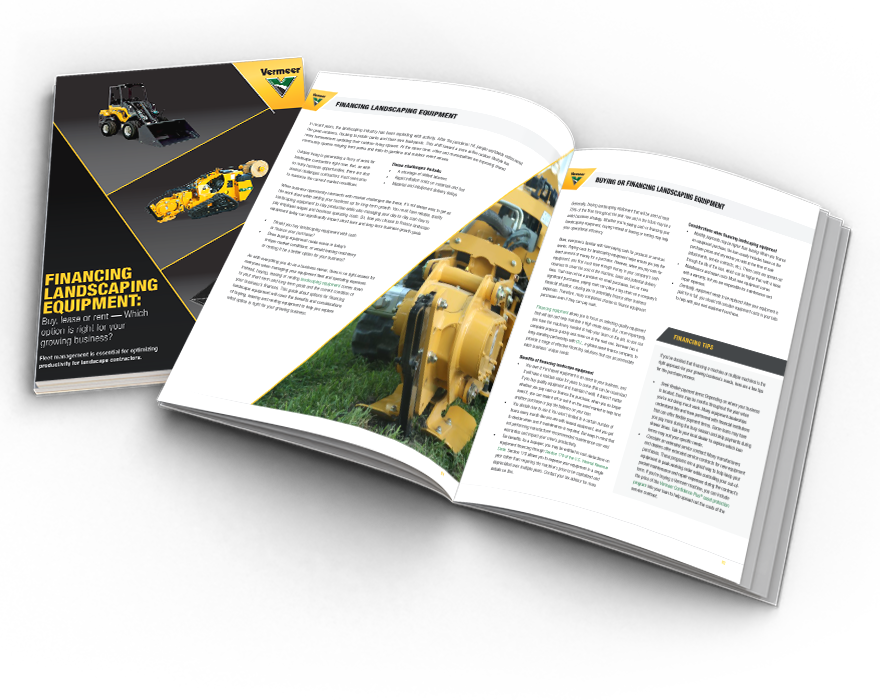Walk-behind trenchers (also known as pedestrian trenchers) are a vital part of a landscape contractor’s equipment fleet. These versatile machines can expand a contractor’s customer base and provide a competitive edge.
Various makes and models of pedestrian trenchers are available, including two options from Vermeer: the RTX130 and RTX250. When a landscape contractor needs a pedestrian trencher, the choice should not be based solely on price. Instead, they should consider the total cost of ownership and the unit that will best enhance productivity. Key factors such as machine control, size, track or tire type, boom length, chain configuration and attachment options should be considered for optimum results.
To rent or buy a walk-behind trencher: What’s best for landscape contractors?
If a landscape contractor frequently undertakes irrigation work or other tasks that require regular trenching, it may be more cost-effective to purchase a dedicated walk-behind trencher. However, for those who only need a trencher a few times each season, renting may be a better option.
Another consideration is whether to choose a dedicated trencher or a trencher attachment, depending on the specific needs and constraints of the job. For example, a dedicated pedestrian trencher has a smaller footprint than most tool carriers, making it a better option when working in tight spaces like narrow gates or close to buildings and fences. Plus, these machines are designed for optimal flotation in sensitive ground conditions, which can minimize the need for remediation work.
Mini skid steers outfitted with trencher attachments are good options for landscape contractors for more substantial renovation projects that require more than just digging a trench.
Intuitive controls for landscape trenching equipment
When evaluating walk-behind trenchers, landscapers should prioritize reliability, user-friendly design and straightforward functionality. Many trenchers might seem similar, but there can be significant differences in ease of operation and optional features that enhance the operational experience. For many landscape contractors, straightforward controls are crucial as multiple team members may operate the equipment. Therefore, controls should be intuitive and allow operators to set and maintain a specific trenching depth.

Optimal engine size selection for walk-behind trenchers
Choosing a walk-behind or pedestrian trencher as part of landscape contractor equipment requires considering engine size as a primary factor. Vermeer walk-behind trenchers come in various engine sizes, such as 13 hp and 25 hp (9.7 kW and 18.6 kW), catering to a broad spectrum of landscaping needs.
Larger machines with higher horsepower generally deliver higher productivity across diverse soil conditions. These machines can accommodate additional boom sizes and chain types, providing flexibility for a range of projects.
Smaller horsepower trenchers offer greater maneuverability in tight working conditions, making them a valuable choice for various landscaping operations.
Understanding the undercarriage of trenchers
Many pedestrian trenchers sold today are equipped with tracks, particularly rubber tracks. These tracks provide floatation in soft or sensitive ground conditions and offer outstanding traction in soft, rocky or muddy conditions with minimal ground disturbance. Additionally, tracks allow for maneuverability and depth control in uneven ground conditions.
Boom selection for walk-behind trenchers
The boom size a landscape contractor needs can also vary. Pedestrian booms typically range from 24 in to 48 in (61 cm to 121.9 cm) in length. The most commonly used are the 24-in, 30-in and 36-in (61-cm, 76.2-cm and 91.4-cm) boom sizes. Aligning the boom size with the horsepower of a trencher and the intended application is crucial to maximize productivity.
Every landscaping job is unique, so the trencher configuration should suit the specific needs of the task. If a contractor is installing an irrigation system, downspouts, cable conduit or even electrical lines, they might not have to trench very deep. However, trenching a waterline in a colder climate or digging footings for a building may require a unit with a longer boom.
Chain configurations for optimal trenching
Consideration of chain configurations is essential for pedestrian trenchers. These configurations determine the width of the cut made by the trencher, typically ranging between 4 in to 8 in (10.1 cm to 20.3 cm).
The teeth of trenchers commonly fall into two categories: cup and rotary cutters. Cupping teeth are designed to efficiently excavate material from the trench, while rotary cutters break up or dislodge solid material like rocks. Chain configurations that use cupping teeth, commonly called soil chains, are more efficient in loose dirt and sandy soils. However, when working in conditions such as rock, trencher operators will need a rock chain with carbide-tipped teeth to dig into these challenging ground conditions.
Several trencher chain configurations integrate cup and rotary cutters. For example, the Vermeer Shark Combo Chain offers simultaneous trenching and cleaning in loam, sandy clay and hard clay, making it a popular option for contractors working with a wide range of soil types.
The spacing of the teeth (pitch) and how they are attached to the chain can affect a trencher’s performance. Closer tooth spacing is suitable for harder ground conditions, while wider tooth spacing works more efficiently on soft or muddy ground. Chains with bolt-on teeth let users adjust the chain configuration. However, welded chains have a low-profile and typically experience less kickback during operation.
Attachment for landscape trenchers
Adding attachments to pedestrian trenchers not only enhances their functionality but also optimizes everyone’s time on the job, boosting productivity. For instance, an optional backfill blade can make filling in a trench more efficient. Additionally, the Porta Bore attachment can significantly improve trenching operations. It allows for a seamless transition from trenching to boring under obstacles such as driveways and sidewalks. This eliminates the need for an additional machine on the job, saving both time and resources.
Optimal trencher selection for productivity
Selecting the appropriate options, features and configurations for a walk-behind trencher proves critical for landscape contractor equipment. This strategic approach can boost productivity and expand business opportunities.
To learn more about Vermeer walk-behind trenchers for landscaping applications, contact your local Vermeer dealership.
Vermeer Corporation reserves the right to make changes in engineering, design and specifications; add improvements; or discontinue manufacturing at any time without notice or obligation. Equipment shown is for illustrative purposes only and may display optional accessories or components specific to their global region. Please contact your local Vermeer dealer for more information on machine specifications.
Vermeer and the Vermeer logo are trademarks of Vermeer Manufacturing Company in the U.S. and/or other countries. © 2024 Vermeer Corporation. All Rights Reserved.

